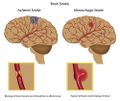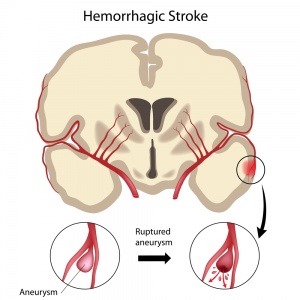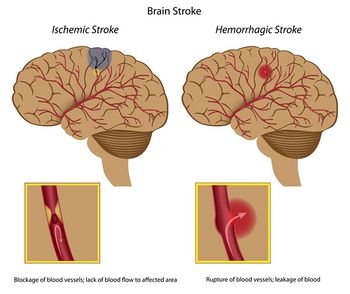Stroke
Stroke is one of the leading causes of death in North America despite improvements with surgical and medical techniques. Prevention is the strategy of choice with evidence showing declines in death rate with increasing management of stroke risk factors. Stroke is usually secondary to atherosclerosis, hypertension or often both.[1] Officially stroke is defined as a loss in nerve function due to lack of oxygen for 24 hours, the prognosis depends on the length and size of the area affected by stroke. Very small strokes can be thought of as TIA or transient ischemic attacks.[2]
|
Stroke | |
| Causes | Alcohol, Smoking, Stress, Lack of movement, Prescription medication |
|---|---|
| See Also | Cardiovascular Conditions, Neurological Conditions, Transient Ischemic Attack (TIA) |
| Books | Books on Cardiovascular Conditions |
| Articles | Articles on Cardiovascular Conditions |
Contents
Naturopathic Assessment
Causal Factors
| Article | Therapeutic Applications of Citicoline for Stroke and Cognitive Dysfunction in the Elderly: A Review of the Literature , Alt Med; 2004;Vol9(1) |
|---|
| Article | Risk of Ischemic Stroke Doubles After a Cup of Coffee , NMJ, ; 2011 February [1] |
|---|
| Article | Acupuncture and Stroke Recovery , NMJ, ; 2011 January [2] |
|---|
In order to stimulate the innate ability of the body to heal the causes of disease must be identified and addressed. With stroke, the causes are variable and include lifestyle and environmental factors and many of the same factors associated with atherosclerosis and Transient Ischemic Attack (TIA). A detailed assessment is required to determine which factors are contributing to stroke.
Lifestyle
- Physical inactivity is associated with increased stroke occurences.[4]
- Sleep disturbances may play a role in stroke risk.[4]
Social
- Socioeconomic Status
- Lower socio-economic status and lack of education may play a role in secondary stroke prevention.[5]
External
Medical Interventions
- Prescription Medications
- Birth control pill use especially after the age of 30.[7]
- Medical Treatments
- Medical treatments such as dental work or surgeries can increase the risk of a stroke in some individuals.
Diagnostic Testing
- A doctor will perform a detailed neurological exam.[8]
Related Symptoms and Conditions
Conditions associated with TIAs and that increase the risk include:[5], [6]
- Obesity
- Hypertension[9]
- Hypotension
- Hypercholestemia
- Diabetes
- Atrial fibrillation
- Carotid stenosis
- Hemorrhage[10]
Characteristics
- Some strokes are mild however others can paralyze, or change previous functions such as speech, or leave an individual in a coma depending on where they occur in the brain and for how long.[2]
The symptoms of stroke are varied and specific to the area of the brain where the stroke has occurred.[8]
- Motor and sensory disturbance.
- Aphasia or inappropriate use of or understanding of language.
- Loss of consciousness, nausea, vomiting.
- Headache, decreased level of consciousness, seizures.
Naturopathic Treatment
The goal of naturopathic treatment is to support and work in tandem with the healing power of the body and to address the causal factors of disease with individual treatment strategies. The goal of naturopathic medicine is to prevent a stroke. The treatment strategies are similar to those of atherosclerosis and hypertension, the two most common Cardiovascular Conditions. Only those treatments that are specific to a stroke are included on this page. For more detail check out atherosclerosis and hypertension.
It is always advisable to work with a naturopathic doctor before engaging in any treatment plan.
References
Reviewed by Iva Lloyd, BScH, RPE, ND [3]
- ↑ Berga S, Bowman M, Drossman D, Faling J, Frenkel E, Gabbard G et al. editors.(1992) The Merck Manual of Diagnosis and therapy 16th edition. Rathway: Merck & Co Inc.;123:pg1450-1456
- ↑ 2.0 2.1 Murray Michael, Pizzorno Joseph (1998) Encyclopedia of Natural Medicine Three Rivers Press, New York:pg335-340
- ↑ Kirshner HS(2008) Therapeutic interventions for prevention of recurrent ischemic stroke. Am J Manag Care;14(6 Suppl 2):S212-26. PMID:18611103
- ↑ 4.0 4.1 Rutten-Jacobs LC, Maaijwee NA, Arntz RM, Van Alebeek ME, Schaapsmeerders P, Schoonderwaldt HC, Dorresteijn LD, Overeem S, Drost G, Janssen MC, van Heerde WL, Kessels RP, Zwiers MP, Norris DG, van der Vlugt MJ, van Dijk EJ, de Leeuw FE (2011) Risk factors and prognosis of young stroke. The FUTURE study: a prospective cohort study. Study rationale and protocol. BMC Neurol;11:109. PMID:21933424.
- ↑ 5.0 5.1 Liu Q, Wang M, Guo J, Li J, Li C, Qian M (2011) Effect of socioeconomic status on secondary prevention of stroke. Int J Qual Health Care;23(4):405-12. PMID:21622716.
- ↑ 6.0 6.1 Sloma A, Backlund LG, Strender LE, Skånér Y (2010) Knowledge of stroke risk factors among primary care patients with previous stroke or TIA: a questionnaire study. BMC Fam Pract;11:47. PMID:20550690.
- ↑ Yang L, Kuper H, Sandin S, Margolis KL, Chen Z, Adami HO, Weiderpass E (2009)Reproductive history, oral contraceptive use, and the risk of ischemic and hemorrhagic stoke in a cohort study of middle-aged Swedish women. Stroke.;40(4):1050-8.PMID:19211494
- ↑ 8.0 8.1 Crocco TJ, Tadros A, Kothari RU (2009) Marx: Rosen’s Emergency Medicine, 7th ed.[internet]. Mosby. Section Seven Neurology Chapter 99 Stroke.[cited 2012 March] Available from: http://co115w.col115.mail.live.com/default.aspx#n=2145351306&st=iva&mid=e0d17dd3-403f-11e1-b486-002264c18e30&fv=1.
- ↑ Mulvihill, Selman, Holdaway, Tompary, Raymond editors (2006) Human Diseases – A Systemic Approach 6th ed. Pearson Education Inc.:pg310-311
- ↑ Smith Fraser, Winterstein James (2008) An Introduction to Principles & Practices of Naturopathic Medicine CCNM Press Inc., Toronto:pg258-260


